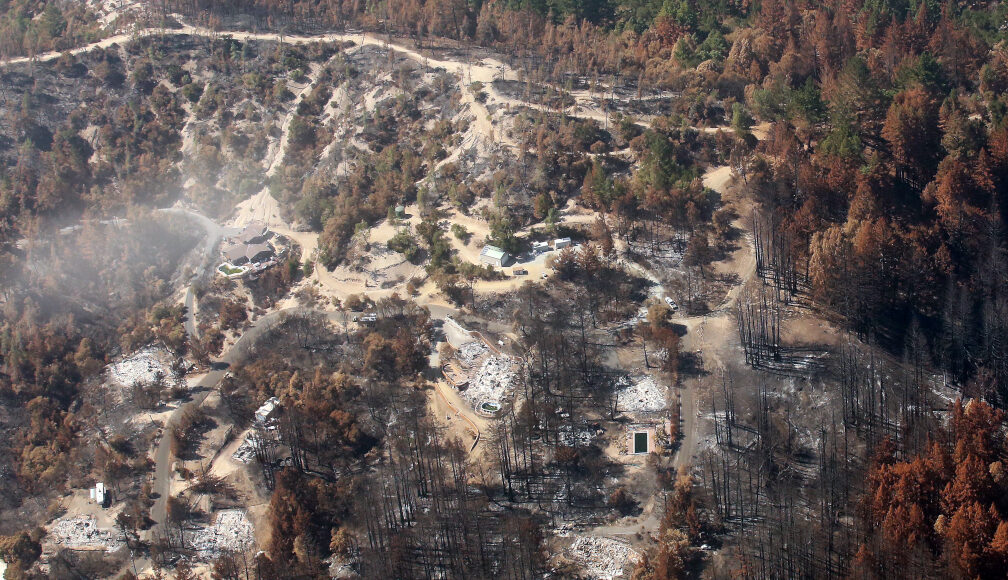When we last spoke in March, Bonny Doon resident Ann McKenzie, whose home burned down in the CZU Lightening Complex fires, was waiting on the county permits so she could start rebuilding her home—and life—after the fires.
Not much has changed.
McKenzie is going on her third year of living without a permanent home. She shares an RV with her husband on the property where their home once stood, and she expects it will be nearly another year before they are able to move into their rebuilt home.
One of the most frustrating parts, says McKenzie, is that they haven’t even been able to break ground. That’s due to the permitting process, which she says has been slow and tedious. McKenzie and her husband originally applied to get pre-clearance permits on April 14, 2021. They finally received them in May of 2022, over a year after they started the process.
McKenzie is now waiting on different permits—and so are the majority of CZU fire survivors.
Two years after the fires, 187 permits are still being processed, and the county has issued 152 pre-clearances.
Out of the 911 homes that were destroyed in the fires, only 11 have been rebuilt.
That leaves a gap of almost 600 homes that are not currently in the process of rebuilding legally. The remaining homeowners could still apply for permits, but in March, Good Times spoke with multiple people who were fed up with the lengthy permitting process—after living for two years in tents or mobile homes, in many cases—and admitted they planned to rebuild illegally, without permits.
County officials say the county has tried to pare down the process as much as possible, by cutting permitting costs, setting up the Office of Response Recovery as a resource to help homeowners rebuild, and hosting informational town halls to help with the permitting process.
As for why only 11 homes have been reconstructed, a county official speculates that contractor scarcity and supply chain issues could be to blame for the large discrepancy between people with permits in hand and finalized homes. CZU fire survivors are looking at higher residential construction costs, a labor shortage problem in construction and building material shortages.
McKenzie’s story illustrates another reason: that even after all pre-clearance permits are issued, there’s still lag time to receive the other necessary permits.
After pre-clearances, owners like McKenzie submit applications for their dwelling units building permit, which includes construction documents, geotechnical engineering report, along with any other required technical material.
McKenzie’s designers submitted those additional permits to 4Leaf, the county’s permitting agency, on July 29.
But to her dismay and frustration, 4Leaf notified her that the Single Family Dwelling permit must be submitted separately from the Additional Dwelling Unit permit, a detail she says no one mentioned beforehand. Her designers are still separating the documents.
The whole permitting process was riddled with small (and not-so-small) setbacks like this one, according to McKenzie. 4Leaf has a processing timeline of 10 days, but McKenzie says the reality tends to be closer to a few weeks, and even sometimes a month.
McKenzie’s story is not unique, especially because the areas hit the hardest by the fires were in the more rural parts of Santa Cruz County. Bonny Doon, Ben Lomand and other areas of the Santa Cruz Mountains were home to the majority of the 911 houses that were burned during the fires.
Those communities have struggled the most to get up to code, according to Michael Renner, Executive Director of 4Leaf. Pre-clearances take into consideration fire access, environmental health-sewage disposal and potential geologic hazards. But the requirements to receive those permits have changed in the time that these more rural communities developed, and many people have lived in the area’s homes for generations.
McKenzie just hopes that she can get all the permits soon—as the rainier months loom, she knows getting the foundation done as soon as possible will be crucial, so that construction can continue throughout winter.
The day she does break ground, McKenzie plans on celebrating—even though it marks the start of another months-long journey,
“I’m gonna have a ceremony and a ribbon cutting, and I’m gonna stand there with a shovel,” she says.














I always wonder how much the open space districts hinder the rebuilding process?